The underlying indicators of good governance in Viet Nam
The concept of "Good governance" was brought to the world in the 1990s in the context
of increasing globalization and expanding democratization worldwide. It can be seen that the
common factors needed to implement good governance include: (i) Capacity of the state - the degree
of problem-solving by governments and leaders religion; (ii) Responsiveness - whether public
policies and institutions meet the needs of citizens and uphold their rights; (iii) Accountability - the
ability of citizens, civil society and the private sector to monitor the responsibilities of public and
governmental institutions.
In Vietnam, from the first decade of the twenty-first century, efforts have been made to set up
indicators and measure the effectiveness of the public authority aligning to the principles of "good
governance". Using data from the four sets of indicators in Vietnam namely PAR, SIPAS, PCI, and
PAPI, this article reviews the process of developing the good governance’s indicators, compares the
areas where each set of indicators measures and assesses the effectiveness, analyzes the strengths
and weaknesses of each set of indicators, and reviews some local government efforts in using the
measurement and evaluation results of the four sets of indicators to improve the quality of
governance in their respective localities. The article also asserts that these four sets of indicators
reflect a large part of the content to be measured according to the principle of "good governance",
and presents some recommendations to improve the four sets of indicators themselves to better
reflect the principles of "Good governance" in the near future.
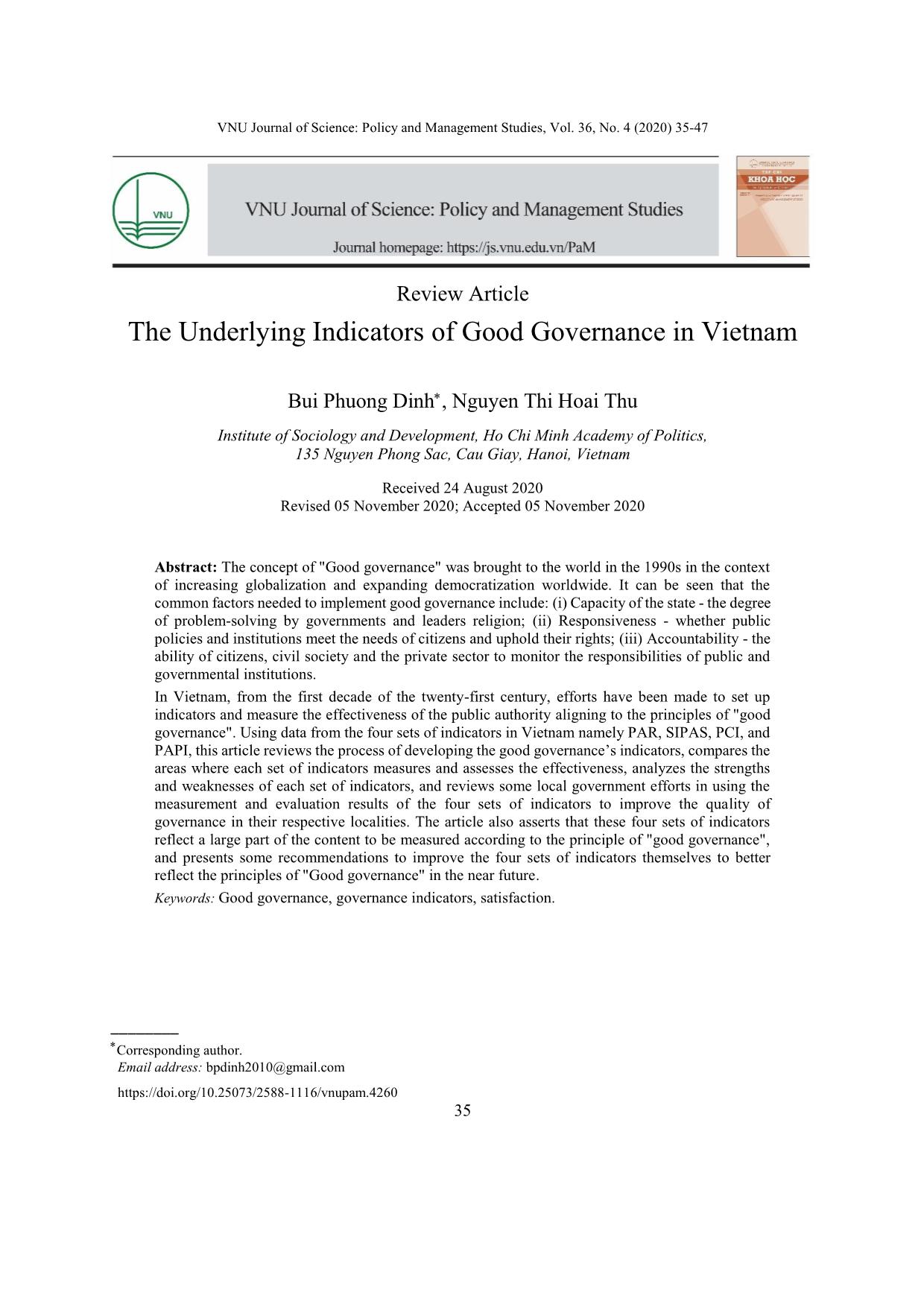
Trang 1
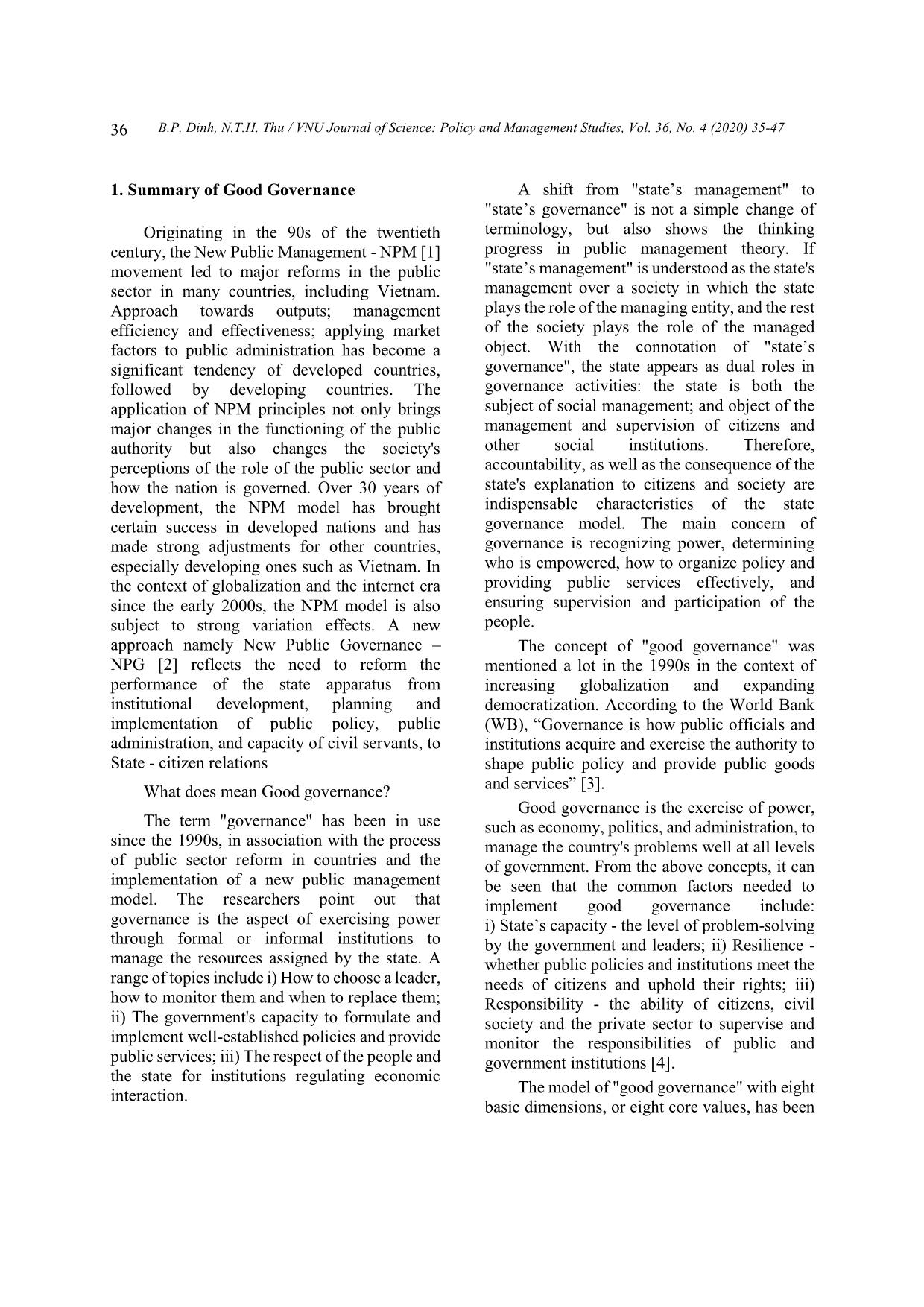
Trang 2
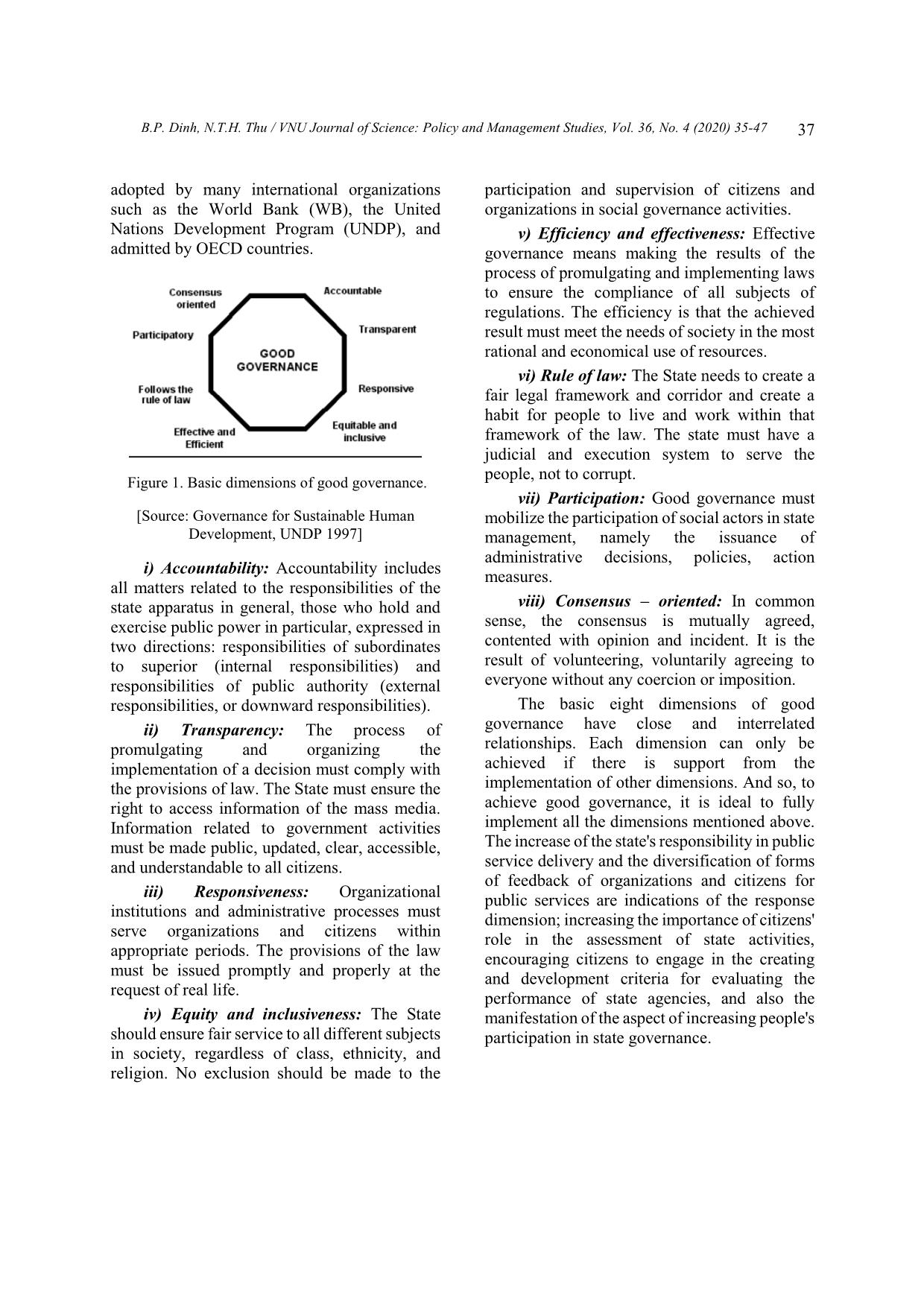
Trang 3
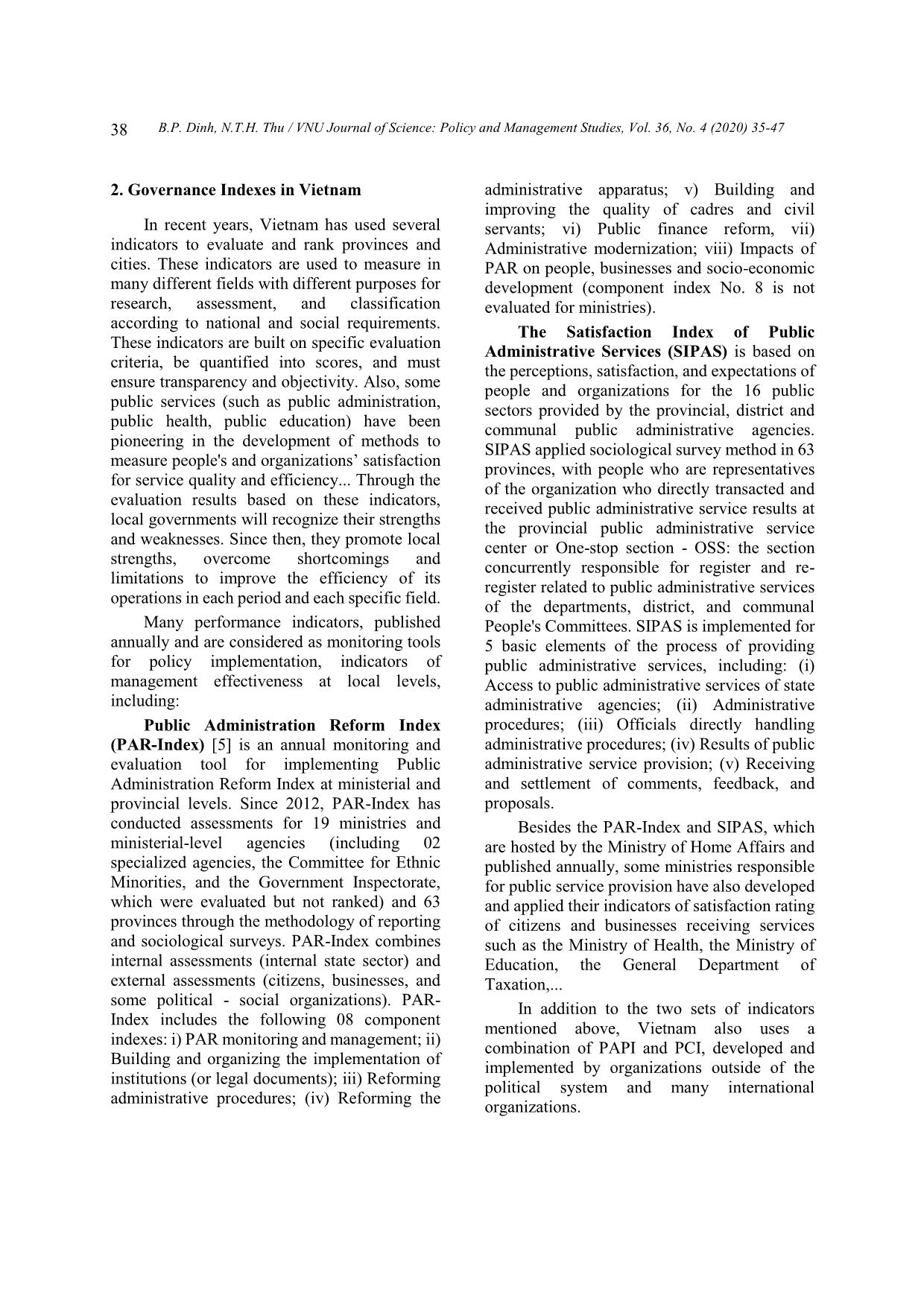
Trang 4
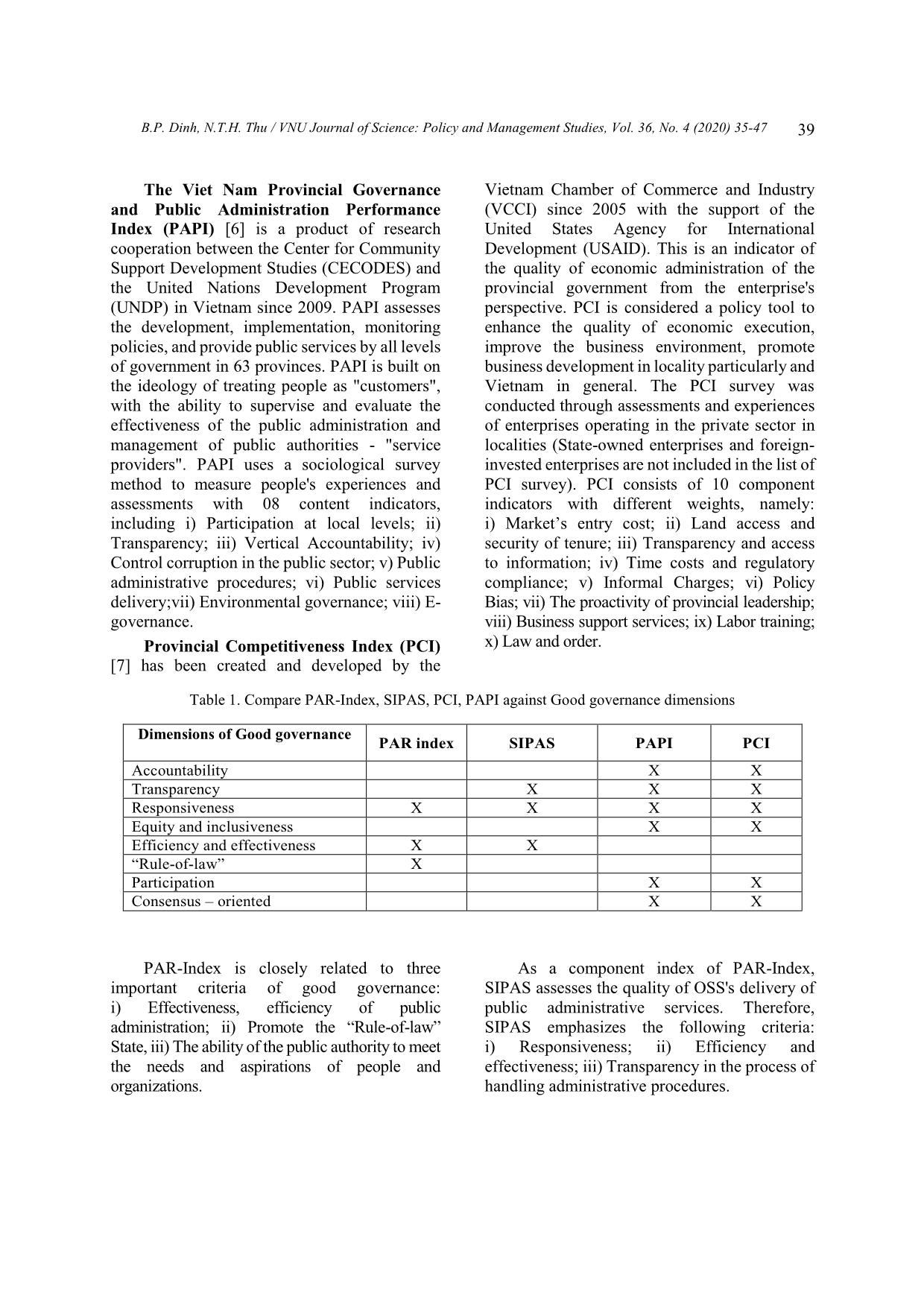
Trang 5
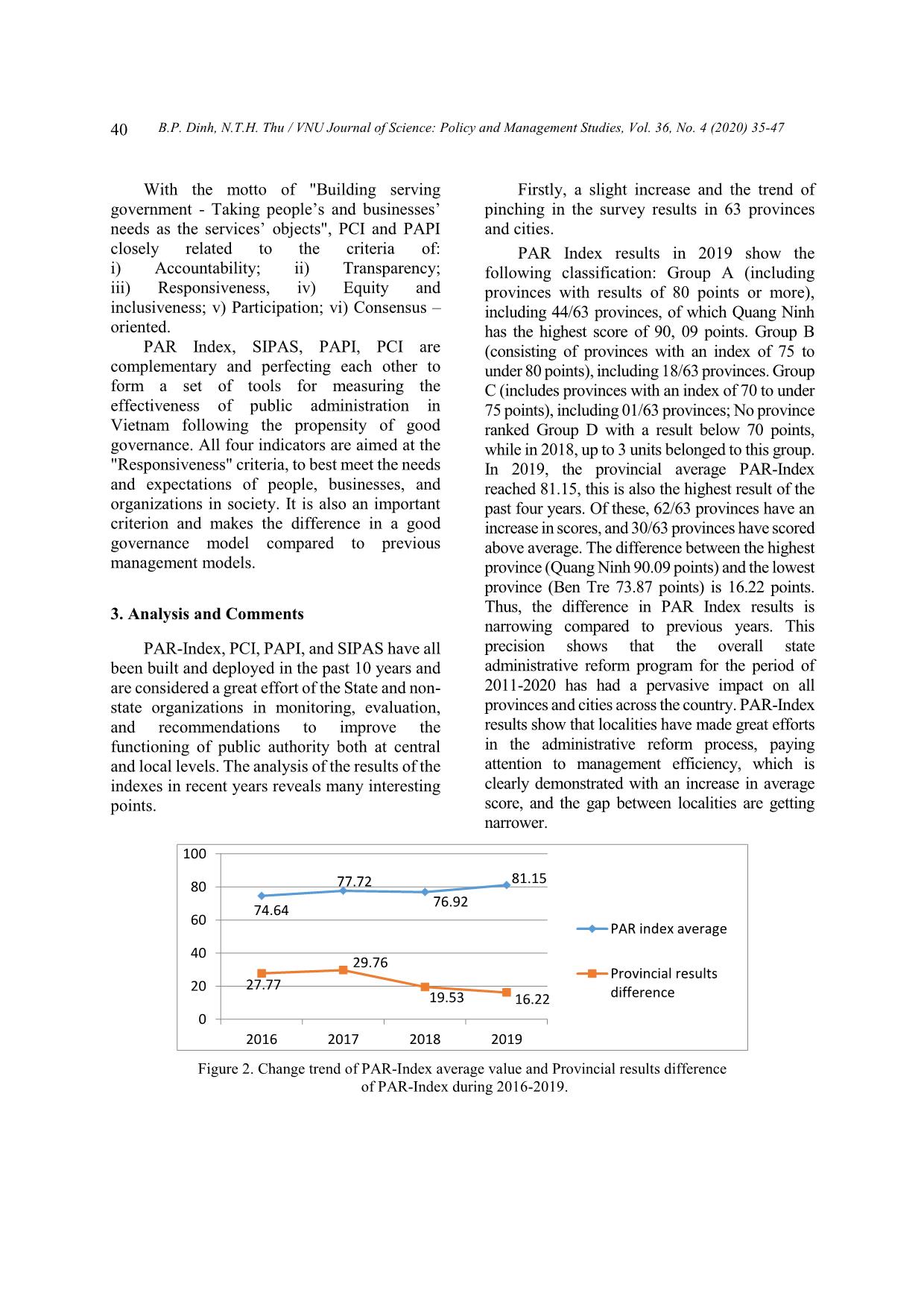
Trang 6
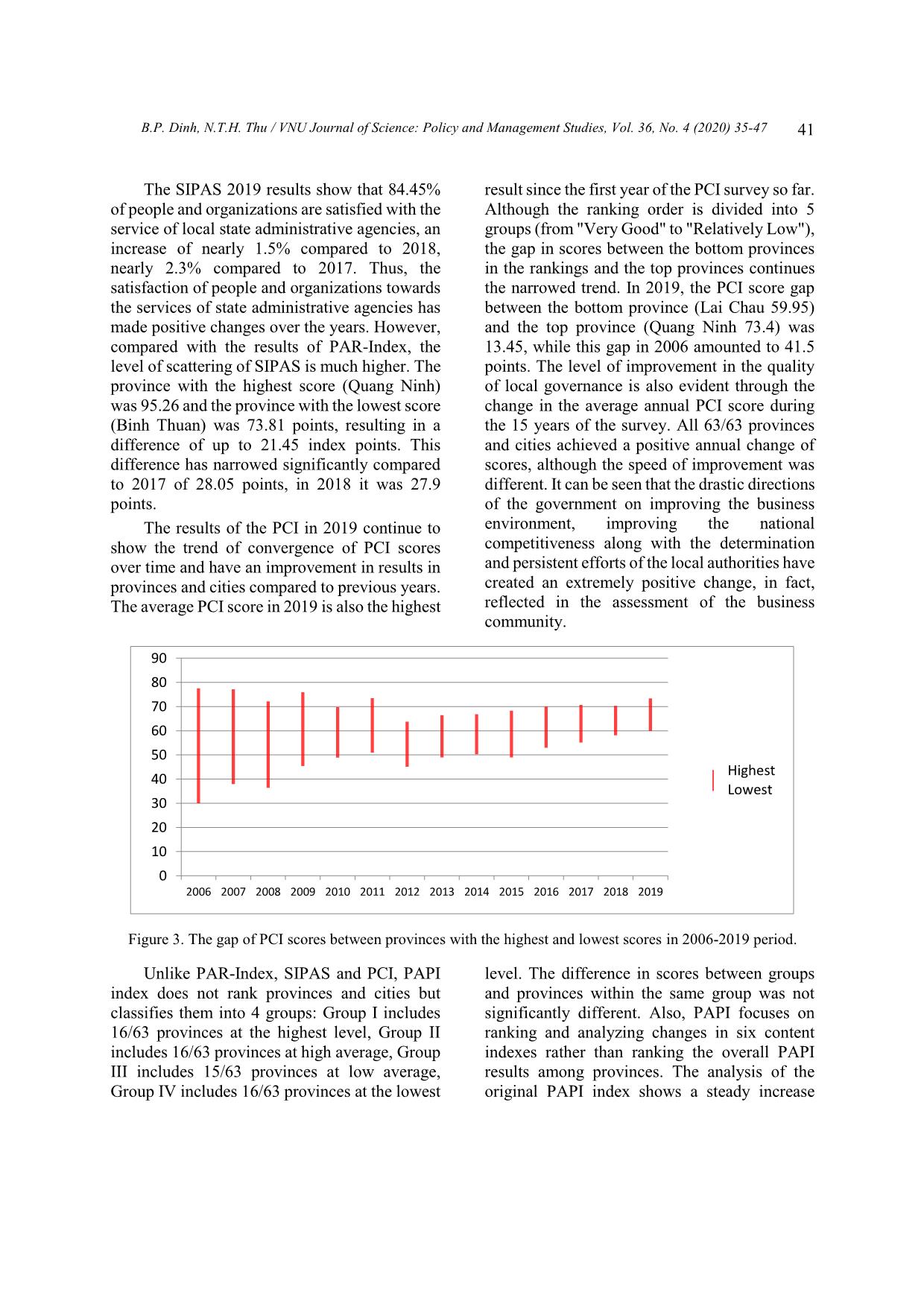
Trang 7
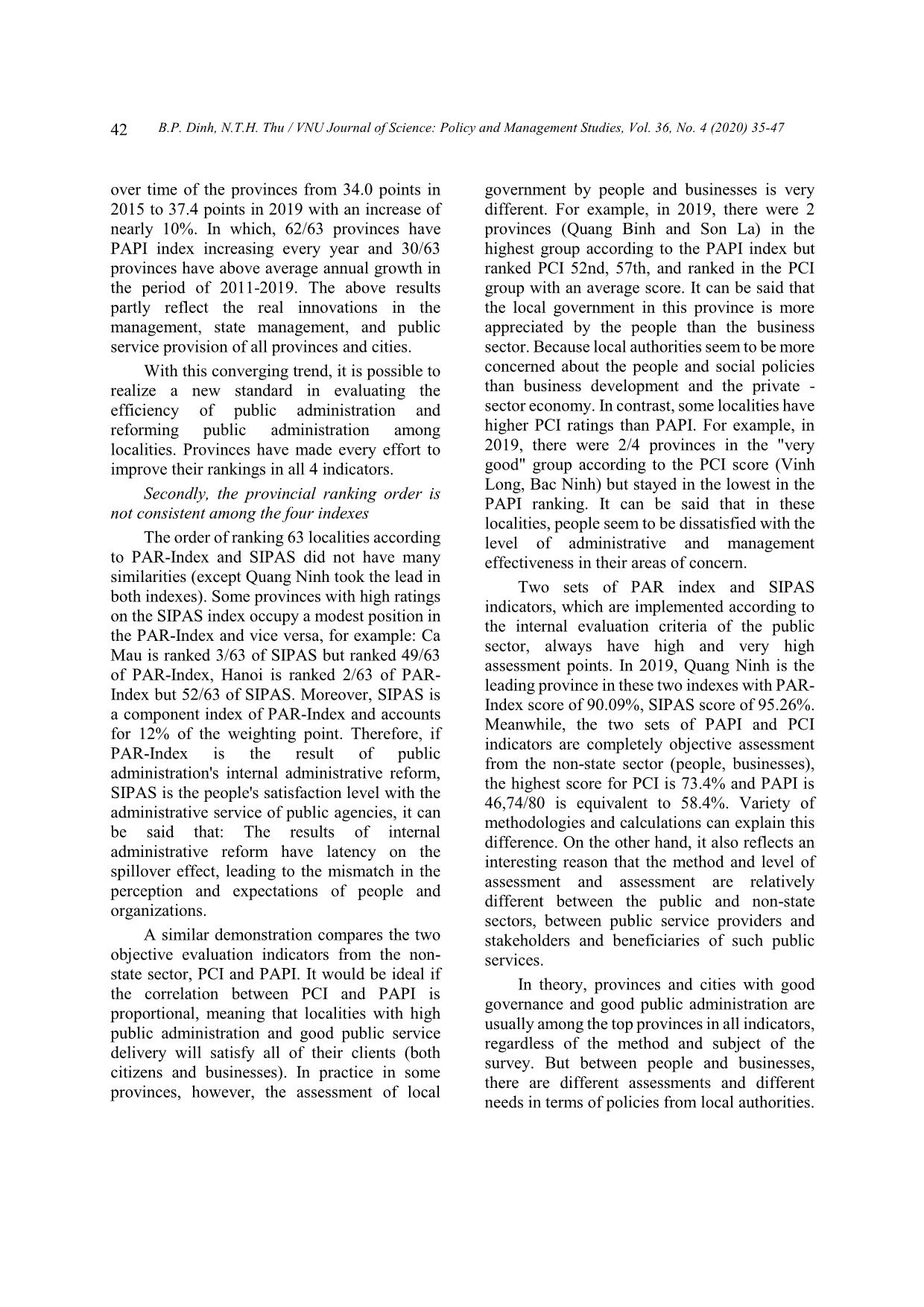
Trang 8
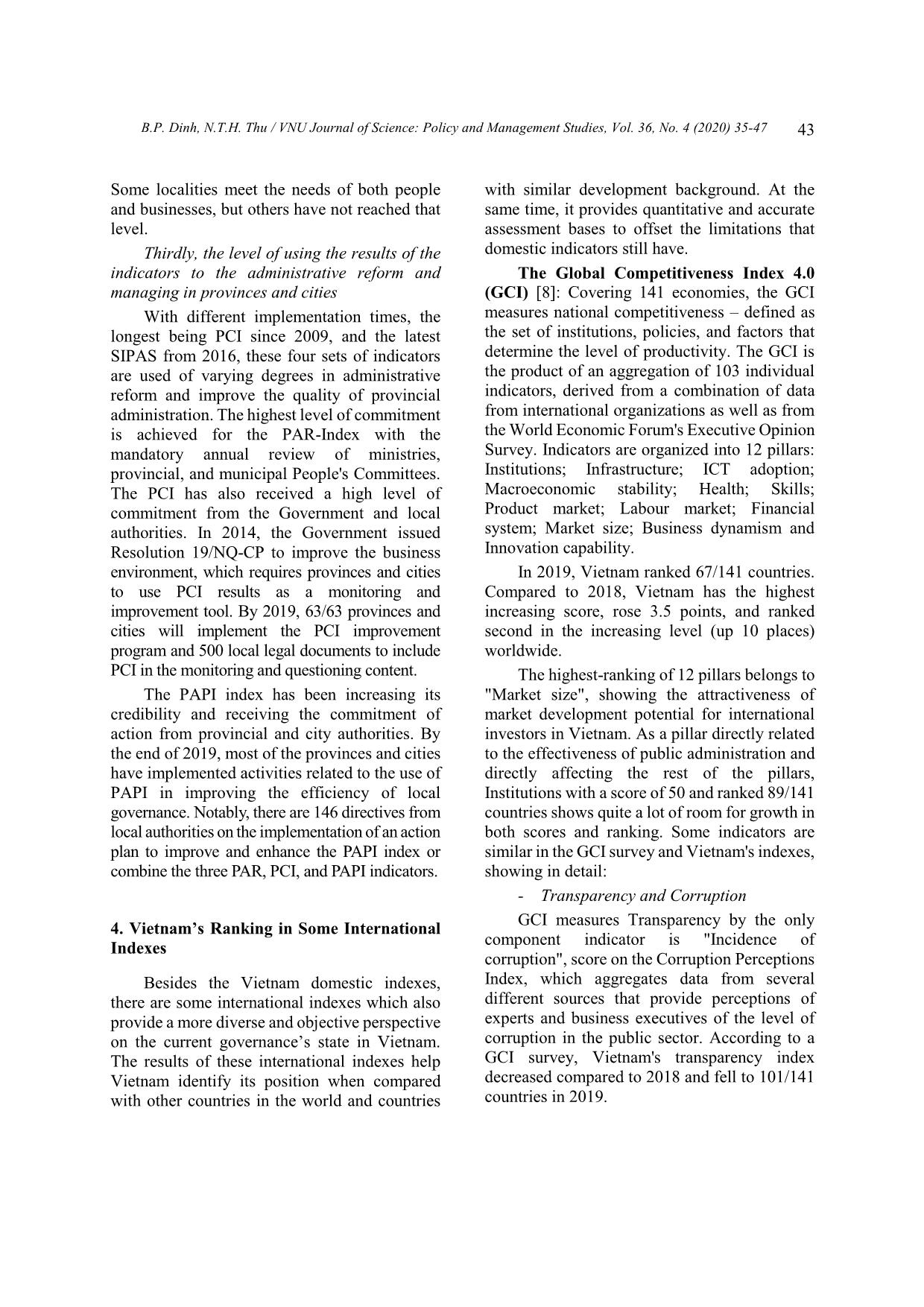
Trang 9
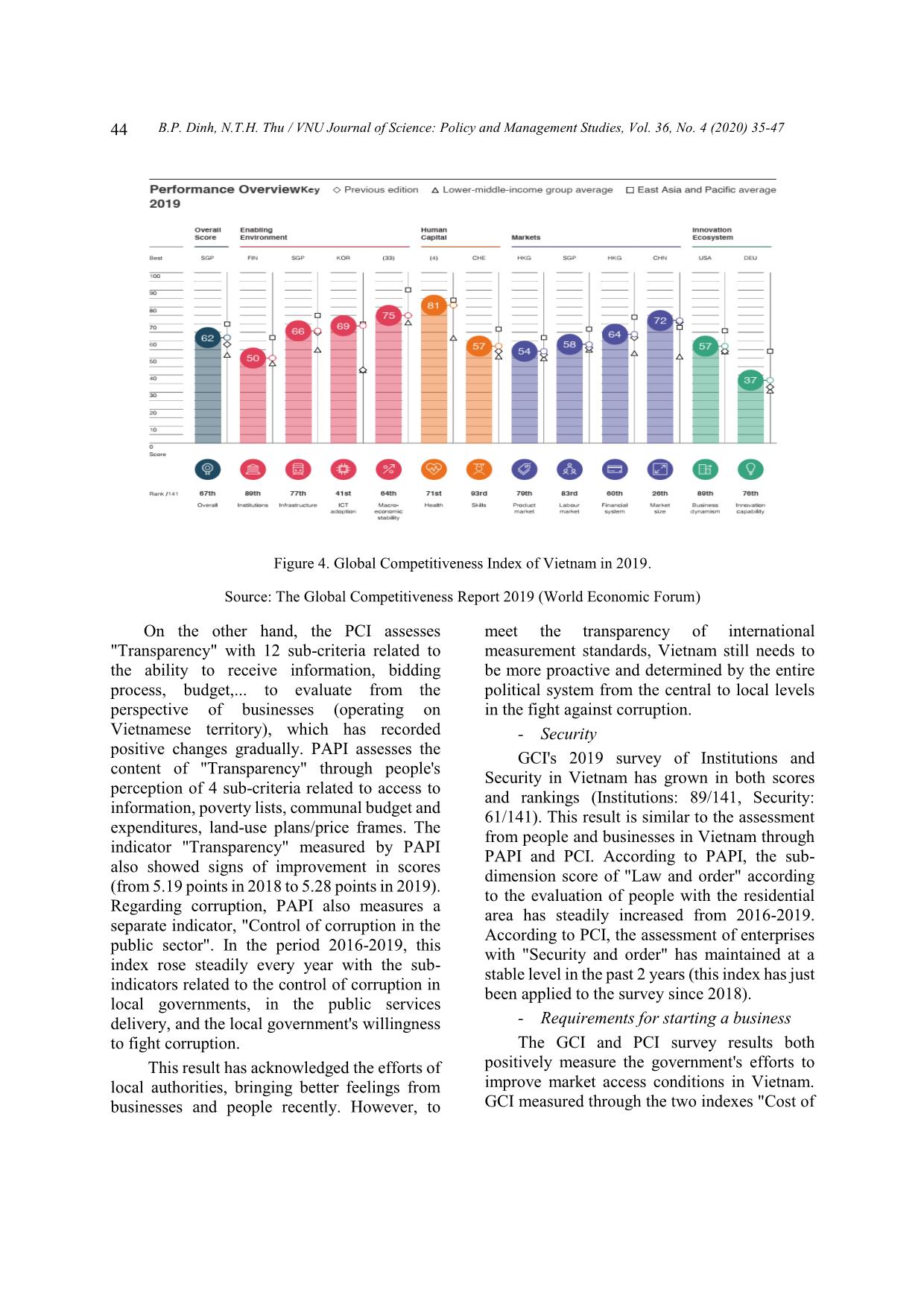
Trang 10
Tải về để xem bản đầy đủ
Tóm tắt nội dung tài liệu: The underlying indicators of good governance in Viet Nam
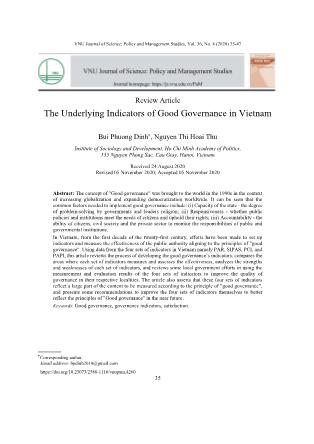
VNU Journal of Science: Policy and Management Studies, Vol. 36, No. 4 (2020) 35-47 35 Review Article The Underlying Indicators of Good Governance in Vietnam Bui Phuong Dinh , Nguyen Thi Hoai Thu Institute of Sociology and Development, Ho Chi Minh Academy of Politics, 135 Nguyen Phong Sac, Cau Giay, Hanoi, Vietnam Received 24 August 2020 Revised 05 November 2020; Accepted 05 November 2020 Abstract: The concept of "Good governance" was brought to the world in the 1990s in the context of increasing globalization and expanding democratization worldwide. It can be seen that the common factors needed to implement good governance include: (i) Capacity of the state - the degree of problem-solving by governments and leaders religion; (ii) Responsiveness - whether public policies and institutions meet the needs of citizens and uphold their rights; (iii) Accountability - the ability of citizens, civil society and the private sector to monitor the responsibilities of public and governmental institutions. In Vietnam, from the first decade of the twenty-first century, efforts have been made to set up indicators and measure the effectiveness of the public authority aligning to the principles of "good governance". Using data from the four sets of indicators in Vietnam namely PAR, SIPAS, PCI, and PAPI, this article reviews the process of developing the good governance’s indicators, compares the areas where each set of indicators measures and assesses the effectiveness, analyzes the strengths and weaknesses of each set of indicators, and reviews some local government efforts in using the measurement and evaluation results of the four sets of indicators to improve the quality of governance in their respective localities. The article also asserts that these four sets of indicators reflect a large part of the content to be measured according to the principle of "good governance", and presents some recommendations to improve the four sets of indicators themselves to better reflect the principles of "Good governance" in the near future. Keywords: Good governance, governance indicators, satisfaction. ________ Corresponding author. Email address: bpdinh2010@gmail.com https://doi.org/10.25073/2588-1116/vnupam.4260 B.P. Dinh, N.T.H. Thu / VNU Journal of Science: Policy and Management Studies, Vol. 36, No. 4 (2020) 35-47 36 1. Summary of Good Governance Originating in the 90s of the twentieth century, the New Public Management - NPM [1] movement led to major reforms in the public sector in many countries, including Vietnam. Approach towards outputs; management efficiency and effectiveness; applying market factors to public administration has become a significant tendency of developed countries, followed by developing countries. The application of NPM principles not only brings major changes in the functioning of the public authority but also changes the society's perceptions of the role of the public sector and how the nation is governed. Over 30 years of development, the NPM model has brought certain success in developed nations and has made strong adjustments for other countries, especially developing ones such as Vietnam. In the context of globalization and the internet era since the early 2000s, the NPM model is also subject to strong variation effects. A new approach namely New Public Governance – NPG [2] reflects the need to reform the performance of the state apparatus from institutional development, planning and implementation of public policy, public administration, and capacity of civil servants, to State - citizen relations What does mean Good governance? The term "governance" has been in use since the 1990s, in association with the process of public sector reform in countries and the implementation of a new public management model. The researchers point out that governance is the aspect of exercising power through formal or informal institutions to manage the resources assigned by the state. A range of topics include i) How to choose a leader, how to monitor them and when to replace them; ii) The government's capacity to formulate and implement well-established policies and provide public services; iii) The respect of the people and the state for institutions regulating economic interaction. A shift from "state’s management" to "state’s governance" is not a simple change of terminology, but also shows the thinking progress in public management theory. If "state’s management" is understood as the state's management over a society in which the state plays the role of the managing entity, and the rest of the society plays the role of the managed object. With the connotation of "state’s governance", the state appears as dual roles in governance activities: the state is both the subject of social management; and object of the management and supe ... implemented activities related to the use of PAPI in improving the efficiency of local governance. Notably, there are 146 directives from local authorities on the implementation of an action plan to improve and enhance the PAPI index or combine the three PAR, PCI, and PAPI indicators. 4. Vietnam’s Ranking in Some International Indexes Besides the Vietnam domestic indexes, there are some international indexes which also provide a more diverse and objective perspective on the current governance’s state in Vietnam. The results of these international indexes help Vietnam identify its position when compared with other countries in the world and countries with similar development background. At the same time, it provides quantitative and accurate assessment bases to offset the limitations that domestic indicators still have. The Global Competitiveness Index 4.0 (GCI) [8]: Covering 141 economies, the GCI measures national competitiveness – defined as the set of institutions, policies, and factors that determine the level of productivity. The GCI is the product of an aggregation of 103 individual indicators, derived from a combination of data from international organizations as well as from the World Economic Forum's Executive Opinion Survey. Indicators are organized into 12 pillars: Institutions; Infrastructure; ICT adoption; Macroeconomic stability; Health; Skills; Product market; Labour market; Financial system; Market size; Business dynamism and Innovation capability. In 2019, Vietnam ranked 67/141 countries. Compared to 2018, Vietnam has the highest increasing score, rose 3.5 points, and ranked second in the increasing level (up 10 places) worldwide. The highest-ranking of 12 pillars belongs to "Market size", showing the attractiveness of market development potential for international investors in Vietnam. As a pillar directly related to the effectiveness of public administration and directly affecting the rest of the pillars, Institutions with a score of 50 and ranked 89/141 countries shows quite a lot of room for growth in both scores and ranking. Some indicators are similar in the GCI survey and Vietnam's indexes, showing in detail: - Transparency and Corruption GCI measures Transparency by the only component indicator is "Incidence of corruption", score on the Corruption Perceptions Index, which aggregates data from several different sources that provide perceptions of experts and business executives of the level of corruption in the public sector. According to a GCI survey, Vietnam's transparency index decreased compared to 2018 and fell to 101/141 countries in 2019. B.P. Dinh, N.T.H. Thu / VNU Journal of Science: Policy and Management Studies, Vol. 36, No. 4 (2020) 35-47 44 Figure 4. Global Competitiveness Index of Vietnam in 2019. Source: The Global Competitiveness Report 2019 (World Economic Forum) On the other hand, the PCI assesses "Transparency" with 12 sub-criteria related to the ability to receive information, bidding process, budget,... to evaluate from the perspective of businesses (operating on Vietnamese territory), which has recorded positive changes gradually. PAPI assesses the content of "Transparency" through people's perception of 4 sub-criteria related to access to information, poverty lists, communal budget and expenditures, land-use plans/price frames. The indicator "Transparency" measured by PAPI also showed signs of improvement in scores (from 5.19 points in 2018 to 5.28 points in 2019). Regarding corruption, PAPI also measures a separate indicator, "Control of corruption in the public sector". In the period 2016-2019, this index rose steadily every year with the sub- indicators related to the control of corruption in local governments, in the public services delivery, and the local government's willingness to fight corruption. This result has acknowledged the efforts of local authorities, bringing better feelings from businesses and people recently. However, to meet the transparency of international measurement standards, Vietnam still needs to be more proactive and determined by the entire political system from the central to local levels in the fight against corruption. - Security GCI's 2019 survey of Institutions and Security in Vietnam has grown in both scores and rankings (Institutions: 89/141, Security: 61/141). This result is similar to the assessment from people and businesses in Vietnam through PAPI and PCI. According to PAPI, the sub- dimension score of "Law and order" according to the evaluation of people with the residential area has steadily increased from 2016-2019. According to PCI, the assessment of enterprises with "Security and order" has maintained at a stable level in the past 2 years (this index has just been applied to the survey since 2018). - Requirements for starting a business The GCI and PCI survey results both positively measure the government's efforts to improve market access conditions in Vietnam. GCI measured through the two indexes "Cost of B.P. Dinh, N.T.H. Thu / VNU Journal of Science: Policy and Management Studies, Vol. 36, No. 4 (2020) 35-47 45 starting a business" and "Time to start a business" both showed an increase compared to 2018, although the ranking is not quite high (respectively, the ranking is 66/141 and 96/141). According to GCI survey data, “Time to start a business" of an enterprise engaging in the Vietnam market is an average of 17 days. This result is also consistent with the PCI survey on "Time to complete enterprise registration procedures". Accordingly, in 2019, 56% of firms completed their business registration procedures in less than 1 month, this is the highest level since 2011. Even 11% of FDI companies said they only take less than a week to get all the necessary documents to officially operate. Worldwide Governance Indicators – WGI [9] reports aggregate and individual governance indicators for over 200 countries and territories over the period 1996–2018, for six dimensions of governance: i) Voice and Accountability; ii) Political Stability and Absence of Violence/Terrorism; iii) Government Effectiveness; iv) Regulatory Quality; v) Rule of Law; vi) Control of Corruption. These aggregate indicators combine the views of a large number of enterprises, citizens, and expert survey respondents in industrial and developing countries. They are based on over 30 individual data sources produced by a variety of survey institutes, think tanks, non-governmental organizations, international organizations, and private sector firms [10]. Instead of the usual ranking among countries, the WGI index classifies the nation in percentile rank from 0 (lowest) to 100 (highest) rank. Figure 5. The trend of sub-indicators of Vietnam's WGI 2014-2018 period. [Source: https://info.worldbank.org/governance/wgi/Home/Reports] The chart above describes the trend of changing 6 WGI sub-indicators of Vietnam from 2014 to 2018 with the following results: Voice and Accountability is the value with the lowest percentile rank and almost no improvement in the past 5 years. The results of this indicator showed that the level of people's participation in selecting their government, as well as freedom of expression, freedom of association, and free media in Vietnam is limited. Although the content and subject of the survey differ, the results of Vietnam's PAPI also show the similarity in the accountability assessment of the local authorities to the people. On a scale of 1-10, the index of PAPI's "Accountability " tends to decrease (2014: 5.73 points, 2019: 4.87 points) shows that local 0 10 20 30 40 50 60 2014 2015 2016 2017 2018 Voice and Accountability Political Stability and Absence of Violence Government Effectiveness Regulatory Quality Rule of Law Control of Corruption P er ce n ti le R an k B.P. Dinh, N.T.H. Thu / VNU Journal of Science: Policy and Management Studies, Vol. 36, No. 4 (2020) 35-47 46 authorities have less effort been made in improving the level and efficiency of contacting and answering complaints and denunciations of the people. Control of Corruption has an unstable, up and down percentile rank and has a decrease at the end of the evaluation period compared to the beginning. Control of Corruption captures perceptions of the extent to which public power is exercised for private gain, including both petty and grand forms of corruption, as well as "capture" of the state by elites and private interests. With the under-median score, this index result is commensurate with the “Incidence of corruption” result in the GCI survey as analyzed above. An interesting finding is that the two international assessments of corruption in Vietnam (GCI, WGI) adversely demonstrate the contrary between the assessment of Vietnamese businesses and people to the government (via PCI and PAPI). In addition to the differences in the evaluation perspective, there is another reason that is the local government's determination to fight against corruption, which has a positive spillover effect and is encouraged by businesses and people, recorded through the review score constantly increasing every year. This element of political determination has not been clearly assessed in two international indicators. The three indicators that had a percentile rank increase during the study period (2014- 2018) and reached the median level were: Political Stability and Absence of Violence/Terrorism; Government Effectiveness; Rule of Law, which shows positive signs in creating a stable political and institutional environment as well as improving the performance of the public authority in Vietnam. From the objective evaluation of the international index (WGI) and the perspective of subjective assessment from within the Vietnamese government system (PAR-Index), it shows the consistency in the final results. Despite the gradual improvement every year, the Regulatory Quality indicator has not yet reached the median (50) of the percentile rank. This result leads to the perception that: The ability of the government to formulate and implement sound policies and regulations that permit and promote private sector development still has room for improvement in a more positive direction 5. Discussion In the second phase of the Master Program on Public Administration Reform 2011 – 2020 [5], Vietnam has built and implemented four sets of indicators to measure and evaluate the performance of public authorities from central to provincial levels. With many component indicators and hundreds of different sub- indicators, these 4 sets reflect the dimensions of the Good governance model that the United Nations announced at the end of the twentieth century. With the combination of both internal (PAR, SIPAS) and external assessment (PCI, PAPI), four sets of indicators have taken on the role of overseeing the administrative and institutional reform process and managing the development domains at provincial and municipal levels. On the other hand, the results of these sets of indicators have attracted the attention of management leaders, as well as policy advisory research agencies to perform in- depth analysis, from which Policy recommendations are pragmatic, aiming at the long-term cumulative (non-breakthrough or speedy) improvement in the activities of provincial-level public agencies. In international comparison, the two sets of Global Competitiveness index - GCI and Worldwide Governance index - WGI are employing different methods of data collection, analysis, and evaluation from those of the 4 indexes of Vietnam. GCI and WGI are integrated indicators from many other international organizations, while four Vietnamese sets of indicators are based on direct surveys of citizens and businesses. However, the results of both the international and Vietnam's 4 indexes show B.P. Dinh, N.T.H. Thu / VNU Journal of Science: Policy and Management Studies, Vol. 36, No. 4 (2020) 35-47 47 general trends in improving the quality of Vietnam's national governance following the direction of good governance: a clear improvement in the Transparency; Rule of Law; Government Efficiency and Effectiveness; but slow and unstable improvement in the aspect of Participatory; Accountability; Control of Corruption. The Covid-19 pandemic showed that the response and control of disease prevention in particular, abnormal incidents and crises in general, is a very important capacity in national governance. However, both the Vietnamese and international indicators related to good governance do not yet have component indicators on crisis handling capacity. With the prospect of the world’s changing geo-political and geo-economy, unpredictable climate and ecological environment change, it is necessary to study and develop additional indicators of crisis management force in the indexes of international governance and each country. References [1] C. Hood, A public management for all seasons? Public Administration -An International Quarterly 69 (1) (1991) 3-19, https://doi.org/10.1111/j.1467- 9299.1991.tb00779.x [2] S. Osborne, The New Public Governance. Emerging perspectives on the theory and practice of public governance, Routledge Publications, 2006. [3] World Bank, Governance – The World Bank experience, 1994, 71468765285964/pdf/multi0page.pdf (accessed 10 May 2020) [4] UNDP, Governance for Sustainable Human Development, https://digitallibrary.un.org/record/3831662, 1997 (accessed 10 May 2020) [5] Ministry of Home Affairs, Socialist Republic of Vietnam, Public Administration Reform Index 2019 – PAR Index 2019, https://www.moha.gov.vn/danh- muc.html?cateid=560, 2020 (accessed 10 May 2020). [6] UNDP and CECODES, Provincial Administration and Governance Index 2019 – PAPI 2019, 2020 (accessed 10 May 2020). [7] Vietnam Chamber of Commerce and Industry, Provincial Competitiveness Index 2019 - PCI 2019, https://www.pcivietnam.vn/en, 2020 (accessed 10 May 2020). [8] World Economic Forum The Global Competitiveness Report 2019, 2020. [9] Worldwide Governance Indicators, https://info.worldbank.org/governance/wgi/Home/ Reports, 2020. [10] D. Kaufmann, Governance Indicators: Where Are We, Where Should We Be Going? The World Bank Policy Research Working Paper 4370, https://www.researchgate.net/publication/2355036 8_Governance_Indicators_Where_are_We_Where _Should_We_Be_Going, 2008 (accessed 10 May 2020).
File đính kèm:
 the_underlying_indicators_of_good_governance_in_viet_nam.pdf
the_underlying_indicators_of_good_governance_in_viet_nam.pdf

